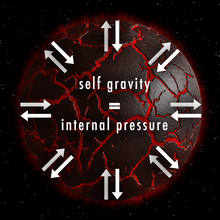
Back Hidrostatiese ewewig Afrikaans توازن هيدروستاتيكي Arabic Хидростатично равновесие Bulgarian Hidrostatička ravnoteža BS Equilibri hidroestàtic Catalan Hydrostatická rovnováha Czech Hydrostatisk ligevægt Danish Hydrostatisches Gleichgewicht German Equilibrio hidrostático Spanish Oreka hidrostatiko Basque
This article needs additional citations for verification. (May 2010) |

In fluid mechanics, hydrostatic equilibrium (hydrostatic balance, hydrostasy) is the condition of a fluid or plastic solid at rest, which occurs when external forces, such as gravity, are balanced by a pressure-gradient force.[1] In the planetary physics of Earth, the pressure-gradient force prevents gravity from collapsing the planetary atmosphere into a thin, dense shell, whereas gravity prevents the pressure-gradient force from diffusing the atmosphere into outer space.[2][3] In general, it is what causes objects in space to be spherical.
Hydrostatic equilibrium is the distinguishing criterion between dwarf planets and small solar system bodies, and features in astrophysics and planetary geology. Said qualification of equilibrium indicates that the shape of the object is symmetrically rounded, mostly due to rotation, into an ellipsoid, where any irregular surface features are consequent to a relatively thin solid crust. In addition to the Sun, there are a dozen or so equilibrium objects confirmed to exist in the Solar System.
- ^ White, Frank M. (2008). "Pressure Distribution in a Fluid". Fluid Mechanics. New York: McGraw-Hill. pp. 63, 66. ISBN 978-0-07-128645-9.
- ^ Vallis, Geoffrey K. (6 November 2006). Atmospheric and Oceanic Fluid Dynamics: Fundamentals and Large-scale Circulation. Cambridge University Press. ISBN 9781139459969.
- ^ Klinger, Barry A.; Haine, Thomas W. N. (14 March 2019). Ocean Circulation in Three Dimensions. Cambridge University Press. ISBN 9780521768436.
© MMXXIII Rich X Search. We shall prevail. All rights reserved. Rich X Search